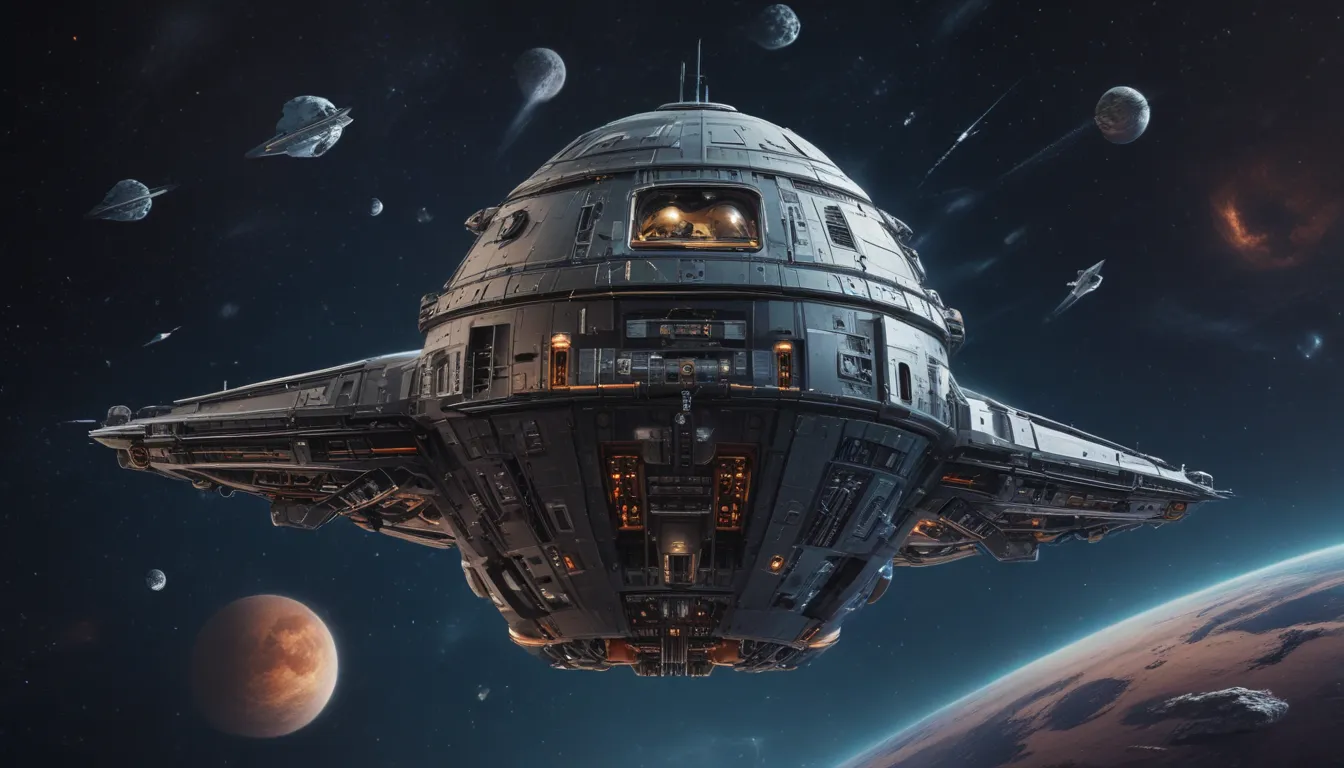The pictures we use in our articles might not show exactly what the words say. We choose these pictures to make you interested in reading more. The pictures work together with the words but don’t take their place. The words still tell you the important facts.
Spacecraft have captivated humanity for decades, serving as our means to explore the vast depths of outer space and unravel the mysteries that lie beyond our planet. These remarkable vessels are a testament to human ingenuity, designed to withstand the challenges of space travel and propel us towards new frontiers. While we may be familiar with iconic spacecraft like the Apollo missions and the International Space Station, there are numerous surprising and fascinating facts about these technological marvels that often go unnoticed. Join us as we delve into 14 unexpected revelations about spacecraft that will leave you in awe of the complexity and innovation behind these cosmic explorers.
Unveiling the Wonders of Spacecraft:
- Spacecraft are not exclusive to NASA; various countries and private companies also contribute to spacecraft development, expanding our knowledge of the universe.
- A testament to human achievement, spacecraft serve as cosmic superheroes, unlocking the mysteries of planets, braving space debris, and journeying beyond our solar system, offering us a glimpse into the vast universe.
The Multifaceted World of Spacecraft:
Spacecraft Know No Boundaries
Contrary to popular belief, NASA is not the sole entity involved in crafting spacecraft. Several international space agencies and private companies partake in the development and construction of these extraordinary vehicles, broadening the horizon of space exploration.
The Pioneering Sputnik
In a groundbreaking moment in 1957, the Soviet Union launched Sputnik, the first human-made object to venture into outer space. This historic event ushered in the era of space exploration, opening doors to new possibilities beyond Earth's atmosphere.
Propelling Through Space
Spacecraft utilize a variety of propulsion systems to maneuver and traverse through the vastness of space. From chemical rockets to ion thrusters and solar sails harnessing sunlight for propulsion, these vessels exemplify the ingenuity of human engineering.
Speeding Through the Cosmos
Designed to overcome the immense distances of outer space, spacecraft can reach staggering speeds. For instance, the Voyager 1 spacecraft, launched in 1977, travels at an astonishing rate of approximately 38,000 miles per hour, showcasing the capabilities of these technological marvels.
Endurance in Space
Crafted to withstand the harsh conditions of space, spacecraft can remain in orbit for extended periods. The International Space Station (ISS), a testament to human collaboration, has been continuously occupied since November 2000, serving as a platform for scientific exploration.
Probing Planets Beyond
Spacecraft embark on missions to explore and study other planets within our solar system, providing invaluable insights into celestial bodies like Mars. Mars rovers such as Curiosity and Perseverance have revolutionized our understanding of the Red Planet, unveiling its geological and atmospheric secrets.
Remote Sensing Insights
Equipped with advanced instruments and sensors, spacecraft engage in remote sensing, gathering data on distant celestial objects. This process enables scientists to analyze and comprehend various aspects of the universe, unraveling the mysteries of the cosmos.
Lunar Landings and Beyond
The iconic Apollo missions orchestrated by NASA between 1969 and 1972 demonstrate the efficacy of spacecraft in landing humans on the moon. This monumental accomplishment marked a significant milestone in human space exploration, inspiring generations to reach for the stars.
Expanding Horizons Beyond our Solar System:
Voyager Missions to the Stars
Spacecraft like Voyager 1 and Voyager 2 venture beyond the confines of our solar system, embarking on interstellar missions that provide crucial data about the outer reaches of space. These groundbreaking endeavors push the boundaries of human exploration, unveiling the secrets of the cosmos.
Resilient Reusability
Technological advancements have enabled spacecraft to be designed for reuse, exemplified by SpaceX's Falcon 9 rocket. This innovation allows for the launch of payloads into space, with the spacecraft safely returning to Earth for subsequent missions, fostering sustainability in space exploration.
Paving the Way for Progress:
Satellite Deployment Saviors
Spacecraft play a vital role in deploying satellites into Earth's orbit, facilitating communication, weather monitoring, GPS navigation, and various other essential functions. These satellites serve as integral components of modern-day infrastructure, enhancing connectivity and information dissemination.
Navigating Space Debris Hazards
Navigating through the cosmic sea, spacecraft encounter potential hazards in the form of space debris and defunct satellites. Vigilance is paramount to avoid collisions with these objects, safeguarding the safety and operational efficiency of spacecraft in their missions.
Voyager Missions to the Stars
Spacecraft missions to moons within our solar system, such as the Cassini-Huygens mission to Saturn's moon Titan, yield valuable insights and data about these distant celestial bodies. These endeavors expand our knowledge of the solar system, unraveling the intricacies of planetary moons.
The Future of Space Exploration:
Advancing Endeavors in Space
Spacecraft continue to push the boundaries of space exploration, fueling scientific discovery and innovation. These technological marvels serve as indispensable tools in our quest to understand the universe, showcasing the limitless potential of human ingenuity.
Embarking on a Cosmic Odyssey:
The realm of spacecraft teems with astonishing facts and revelations, from their incredible speed to the cutting-edge technologies underpinning space exploration. Each fact illuminates the unparalleled innovation and dedication invested in the design and operation of spacecraft, fostering a deeper appreciation for these cosmic vehicles. As we unravel the enigmatic world of spacecraft, the limitless potential of human ingenuity unfolds before us, paving the way for groundbreaking discoveries and advancements in spacecraft technology. The journey of space exploration beckons with boundless possibilities, inviting us to delve deeper into the captivating realm of spacecraft and the wonders they hold.
FAQs:
- How fast can spacecraft travel?
-
Spacecraft can achieve remarkable speeds, with some reaching up to 36,000 kilometers per hour (22,000 miles per hour).
-
How long can a spacecraft stay in space?
-
The duration of a spacecraft's mission in space is contingent on several factors, including its design, fuel capacity, and objectives. Spacecraft like Voyager 1 and 2 have traversed space for over four decades, exemplifying endurance in the cosmic expanse.
-
What are the main challenges of space travel?
-
Space travel presents various challenges, including the impact of microgravity on the human body, radiation exposure, and the intricate life support systems required to sustain astronauts during missions.
-
Can spacecraft land back on Earth?
-
While not all spacecraft are designed for reentry, some are capable of returning to Earth, such as the Space Shuttle, which landed like an airplane. However, one-way missions, like satellites or probes, are also prevalent in space exploration.
-
How many people have traveled to space?
- Approximately 570 individuals from diverse countries have journeyed to space, with this number steadily increasing as space agencies and private enterprises democratize access to space travel.
Delving Deeper into the Cosmos:
Spacecraft serve as testaments to human ingenuity, facilitating space exploration and unveiling the marvels of the universe. Embark on a cosmic adventure as we delve into the realm of spacecraft data analysis, shedding light on hidden patterns and insights through cutting-edge techniques. Witness the awe-inspiring autonomy of spacecraft systems as they navigate the cosmic tapestry with unparalleled precision. Dive into the captivating world of spacecraft propulsion, where ion engines and solar sails propel vessels through the cosmic vastness. Join us in unraveling the astounding wonders of space exploration, as we navigate the cosmos alongside these technological marvels.
Our Commitment to Quality:
Our dedication to providing authentic and engaging content drives our mission to deliver trustworthy insights to our audience. Each fact shared on our platform is a contribution from real users like you, offering diverse perspectives and knowledge. Our team of editors meticulously reviews each submission to ensure the highest standards of accuracy and reliability, guaranteeing that the information we share is not only captivating but also credible. Trust in our commitment to quality and authenticity as we explore the realms of spacecraft and beyond, igniting curiosity and expanding horizons through the wonders of space exploration.






